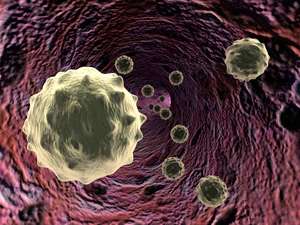Revealing the differences between subsets of immune cells in the blood

The tweaking of genetic material that instructs immune cell function may be able to slow or stop the progression of disease, research by A*STAR suggests.
White blood cells called monocytes comprise 5–10 per cent of immune cells in the blood, and play an important role in protecting the body against foreign invaders by consuming viruses and bacteria, and alerting other immune cells to potential threats. Until recently it was assumed that there was just one kind of monocyte, but research indicates that there are at least two, which can be differentiated by the presence or absence of a molecule called CD16 on their surface.
CD16 positive cells are particularly interesting, because they are prolific in people with infectious diseases like HIV, inflammatory conditions such as sepsis, and autoimmune disorders like multiple sclerosis. "Nobody really knows the function of these cells or the consequence of this cellular expansion during disease processes," says Siew Cheng Wong of the Singapore Immunology Network at A*STAR. "Are these cells helping to control disease or does the expansion of these cells contribute to the pathogenesis?"
To further investigate CD16 cells, Wong and her colleagues turned to pieces of genetic material called microRNAs, which simultaneously control the expression of multiple genes. They identified 66 microRNAs which are expressed differently between CD16 positive and negative cells.
Further experiments revealed that many of the microRNAs regulate genes involved in the migration of cells to different sites around the body, and programmed cell death. Others, such as miR-345, seem to control the magnitude of the immune response by regulating production of proteins called transcription factors, which bind to genes and regulate how they are transcribed into messenger RNA. "Our data suggest these microRNAs could make a substantial contribution to regulating the functions of human blood monocytes," says Wong.
Now that these master regulators have been identified, the next stage is to investigate how up-regulating or blocking their activity might influence monocyte activity and the course of disease. Already, companies are developing drugs that might target microRNAs involved in other diseases, such as those affecting the heart. In future, individuals' immune responses could also be tweaked by targeting microRNAs expressed by monocytes. "MicroRNAs have multiple targets and so might be more useful as a point of therapy than just targeting a single gene or protein," says Wong. "We would be hitting a master regulator of the cell."
More information: Truong-Minh Dang et al. MicroRNA expression profiling of human blood monocyte subsets highlights functional differences, Immunology (2015). DOI: 10.1111/imm.12456



















